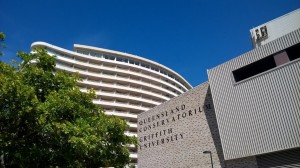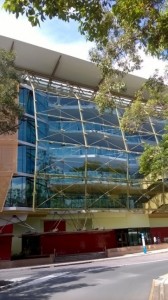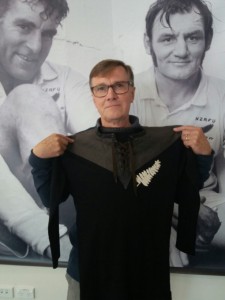
In this last blog post from Peter Littlejohns from New Zealand and Australia, he reflects on the value of international collaborative interdisciplinary research and his ideas for the future of the CLAHRC’s public health theme’s research.
December saw me returning to Griffith University in Brisbane, Australia. But this time rather than going to the rural Nathan Campus, my host Professor Paul Scuffham and I set off to its Gold Coast Campus to give another lecture on public involvement in health care prioritisation and view its brand new health research building and hospital.
I was delighted to see an old colleague in the audience for my presentation, Professor Paul Glasziou. Paul is Professor of Evidence-Based Medicine at Bond University, Queensland as well as still being a part-time General Practitioner and another full-time surfer.
Our paths had crossed when I was Clinical and Public Health Director at NICE and he was the Director of the Centre for Evidence-Based Medicine in Oxford from 2003-2010. His key interests include identifying and removing the barriers to using high-quality research in everyday clinical practice. He is the author of six books related to evidence-based practice including ‘Integrating evidence and values, an Evidence-Based Medicine Workbook’. So, you can imagine his ‘I only have 2 questions for you Peter…’ at the end of my lecture went to the heart of what we are trying to do with the CLAHRC project.
We need to demonstrate the effectiveness and cost effectiveness of our approach of integrating values and evidence in a robust way, and I will return to that at the end of the blog. We were joined by Professor Paul Burton for lunch – three Pauls and one Peter must be more than a coincidence. Paul (B) is a Professor of Urban Management and Planning with a particular interest in public participation and community engagement in theory and practice.
He was involved with our first collaboration looking at public perceptions of value. Now at Griffiths, but previously in the Department of Population Health Sciences at Bristol University, UK, where he jointly led with Professor Madeleine Murtagh, the Data Research Group. The Group is an exemplar of cross-disciplinary collaborative research in data science (D2K) related to health and biomedicine, drawing on bioinformatics, epidemiology and statistics, and the social sciences and humanities. It is based on the concept that human interaction and social context are central to data science design, development and application.
I followed this meeting with a further presentation and research discussion session with Paul Scuffham’s team at their impressive Applied Health Economics Department in the Sir Samuel Griffith building on the Nathan Campus. The building is named after Sir Samuel Walker Griffith (1845 – 1920) an Australian politician, Premier of Queensland, Chief Justice of the High Court of Australia and a principal author of the Constitution of Australia.
At my presentation I described the background to my research and we discussed a short and long-term research programme. We decided to produce a film based on our original collaborative research project comparing a citizen jury deliberative approach with discrete choice experiments, which assessed the Australian public’s view on attendance at A&E departments and bariatric surgery for treating obesity.
The following day was the beginning of the holiday bit of the trip. Five days on the Whitsunday Islands to visit the Great Barrier Reef before returning to the UK on the 19 December. This allowed time to reflect on the whole trip and the implications for my CLAHRC project.
First, viewing what is happening in the UK from the other side of the world is salutary. Brexit is no better 10,000 miles away. The view of people here is that the UK really does not know what it is doing and is lacking a strategic direction. I cannot disagree with that but what is really unclear is what the implications are for research and the health service. However, while collaboration with European colleagues may become more complicated, the opportunities for learning between the UK, New Zealand and Australia are immense.
Second, while I have emphasised the productive times and new learning that the last two months have generated, it has not all been halcyon days. Like Winston Churchill I was visited by ‘black dog’ moments or to be more precise some ‘All Black’ moments. It just so happened that I was in Palmerston North New Zealand on the 25 November, the day that Wales were due to play New Zealand, otherwise known as the ‘All Blacks’ in the Autumn rugby union series. There I visited the New Zealand National Rugby Museum, which reinforced the sad fact that the last time Wales had beaten New Zealand was in 1954 (the year before I was born). Could history be made tonight?! Could Wales win for the first time in my lifetime?! Well, of course it wasn’t to be. The All Blacks won their record 30th game in a row against Wales 33-18, but it wasn’t all one-sided.
The black shadow was soon dispersed however as following a Skype interview I was appointed as the lead for education in the new School of Population and Environmental Sciences, created as part of the King’s College London restructuring. A great opportunity to expand my ideas on education of professionals and the public in the need for evidence-based medicine, and combining values and evidence to improve health care.
Third, I was able to consolidate my ideas on how to expand the CLAHRC public health research theme. This comes at a convenient time as the CLAHRC is now beginning to consider what a new version could like when the current programme finishes in 2019. In summary, I want to create an international interactive resource (website) to stimulate public and professional debate over fair and evidence-based approaches to deliver health services that can reduce inequalities in health experience. This will be based on the DMAT with a range of country-specific films and case studies to demonstrate what can be done through international interdisciplinary research. The whole programme will be considered a complex public health intervention and evaluated according to the MRC model.
In some ways, this approach is seeking to replicate what was successful in my previous incursion into international collaborative research. In the late 1990s I was successful in attracting EU funding though its Biomed II funding stream to develop better ways of supporting the development of high-quality clinical guidelines. This built on my UK project which was supported by the NHS R&D programme. This research resulted in the development of the St George’s Clinical Guideline Appraisal Tool and my unit becoming the UK Centre for assessing guidelines. It was this approach that was further developed and refined to become the core of the international project. The project resulted in the creation of the AGREE (Appraising Guidelines, Research and Evaluation) instrument which has been endorsed by the EU, the WHO and the Council of Europe as the standard approach to assessing the quality of clinical guidelines. It has since been translated into 25 languages.
To further develop and ensure the integrity of the instrument we created the AGREE Research Trust of which I was the founding member and trustee. This continues to develop new research ideas and projects, coordinated by colleagues in McMaster University as the the AGREE II programme. It is this approach that we want to replicate with the new expanded DMAT project.
I am now preparing to return to the UK in time for Christmas, although you will be reading this in January. With the temperature in the Whitsunday Islands at 30 degrees and the sun shining, London seems a long (a very long) way away.
Dawn on Hamilton Island with Passage Peak (highest point) on the right

View of the Whitsunday Islands from Passage Peak, later that morning





Leave a Reply